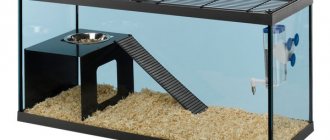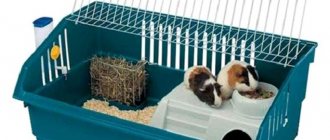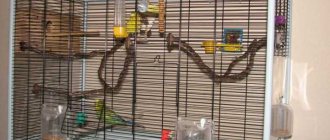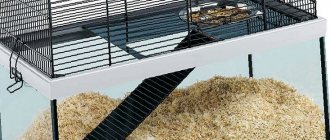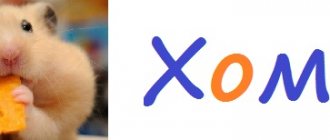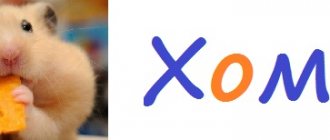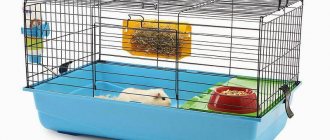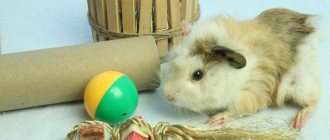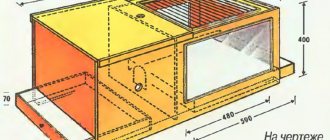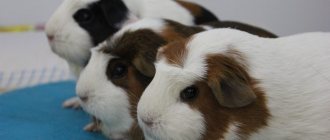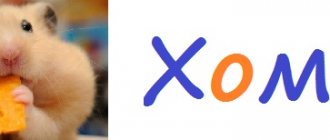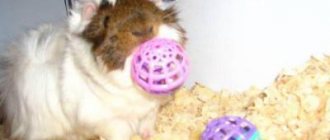What types of cages are there for guinea pigs?
A guinea pig cage can be in the form of an aquarium or terrarium, dune or lattice. But are all types of cages suitable for keeping rodents?
Aquarium
This type of home is a rectangular glass container. Tightly closed walls prevent scattering of filler around the animal’s “apartment” and drafts. But in such a home there is no air ventilation. Animals breathe stale air, pet feces emit a stench, and harmful bacteria multiply faster, which leads to animal diseases.
Therefore, this type of housing is not recommended for pigs.
Dune
Such a home looks more like a plastic container. Its upper part is made with a lattice door, the lower part is blank. The advantages of this type include: cleanliness around the cage, mobility.
Disadvantages: lack of sufficient ventilation, modest size.
A dune-type device is convenient for taking your animal to the veterinarian or for moving. But for permanent housing for the animal, a more spacious option is needed.
Cell
A pig cage is the most suitable option, as it consists of a plastic tray with high walls and a lattice top. The fact that the walls and roof of this type of housing are lattice allows the air inside the cage to constantly circulate. Hammocks, nipple drinkers, and salt stones are also attached to the grates. The disadvantages of such housing include debris around the cage, inconvenience of carrying, and small size.
Aviary
Another type of housing is an enclosure for a guinea pig. Enclosures are fences that limit a certain area. The walls of the enclosure can be made of wood or metal lattice. Such structures do not have a roof or a pallet. Enclosures are good because they have good air ventilation, they can be assembled into the desired shape, and they can be made with your own hands. The walls of such devices must be at least 40 centimeters.
Pet stores sell cages for birds, chinchillas, and hamsters. They are not suitable for pigs. The hamster's housing is too small. The pig will be cramped in such a space and will become depressed.
A two-story cage designed for hamsters and birds is dangerous for pigs. It is difficult for animals to maneuver in such small areas. There is a risk of falling, which can lead to injury to the animal. For pigs, a large cage size is required.
Toys
Toys are added for interest. Paper bags, crumpled paper, cardboard boxes, balls, wooden blocks, hard plastic cat and rabbit toys, fleece tunnels, small fleece blankets and hanging bird toys may be of interest to your guinea pigs.
Just make sure there are no small parts that could come off or be chewed off and swallowed.
Wheels and exercise balls are not recommended; Many experts believe that guinea pigs' bodies are not designed for this type of exercise and the risk of injury is too great. Try to do the exercises using other means.
Guinea pig cage size
Pigs are very active animals. They need to exercise a lot to maintain good physical shape. Therefore, large cages are suitable for them. City apartments may not always allow for a large space for a pet. Veterinarians recommend setting aside at least one square meter of space for each pet. It is also necessary to take into account the height of the “ceilings” in the rodent’s home; the height of the walls must be at least 40 centimeters so that the animal can stand on its hind legs.
If the size of the living space does not allow you to provide the required size of housing for the rodent, then you can get by with a small cage in which the pig will rest at night. During the day, the animal is released into a specially fenced and prepared space so that it can run around to its heart’s content. At the same time, the animal must have access to food, water and a sleeping place.
If you have a summer house in the summer, it will be useful for the animal to spend time in the fresh air. Owners set up enclosures in their summer cottages and let their pets out to frolic on the grass.
Types of enclosures for pigs
In the summer, experts recommend releasing pigs onto the grass, giving them a little freedom. Ideally, summer residents will be able to do this by taking a portable enclosure with them. If you don’t have money for an enclosure, you can drive small pegs into the ground and stretch a tight mesh. Despite the simplicity of such a structure, an enclosure of this type will not protect your pet from uninvited guests. The greatest danger comes from cats, dogs and birds of prey flying past. If the pig is in an enclosure without a cover on top, it must be under constant supervision.
Enclosures have different internal designs. For the convenience of the animal, you can build tunnels and indoor labyrinths where it can hide from danger. Additions are most often constructed from balsa wood or oak. Bridges can be made from tree bark; they increase the endurance of animals. In the pen itself, you can place additional equipment in the form of toys and other accessories at the owner’s discretion. The floor of the enclosure should be equipped with linoleum or absorbent film. Pieces of an old rug will do. Do not forget that the cage needs periodic cleaning.
Do not give your animal plastic objects, feeders or drinking bowls. Your pet may chew on such objects and injure themselves on the edges of the bitten plastic. Walking for your pet can be organized using a purchased ladder.
Country type enclosure
In the summer, many owners take their pet with them to the dacha in the summer. To make the animal comfortable, you can build a special country-type enclosure. The enclosure is built according to the previously agreed method - stakes are driven into the ground and the net is stretched. You can also pull it on top for greater safety for your pet.
An aviary of a more reliable design is usually made of solid wood. From the outside it looks like a box without a top. It can be attached if you want to protect your pet from uninvited guests like birds of prey, but then you should take care of ventilation. It is distinguished by its spaciousness and proper insulation using special means. The bottom is retractable, which ensures comfortable care by the owners. The surface of the box should be treated a couple of weeks before departure with a protective agent that will prevent rotting and the appearance of various bacteria and putrefaction, and will also protect from moisture.
It is important to remember that you only need to treat the outer part of the enclosure, since the pig may begin to chew on the wood and be poisoned by chemicals. Usually the pen is left in the shade of trees, but if it starts to rain, the pet should be brought into the house
Design
The pet's housing should be spacious and safe, and it should be convenient for the owner to clean the cage and remove the animal from the outside. Single-story structures with solid shelves and ramps are suitable for pigs. Lattice surfaces are not suitable as paws can get stuck in them. The bottom of the device is a plastic tray, which is attached to the lattice top with special latches. The fastening must be strong so that the structure can be moved with the pet inside. If there is no room in the cage for a shelf, then the roof of the rest house can serve as its role.
So that the owner can easily reach the animal without injuring it, a wide door is needed.
It is recommended to choose a distance between the rods of about 2.5 centimeters. Such gaps will prevent the animal from getting stuck. Before use, you must check the structure for sharp corners and crevices. If they exist, they are eliminated, as it is dangerous for the animal.
The place where the pet will spend most of its time should be quiet and calm, hidden from sunlight and drafts. If a pet lives alone, then its housing is placed in a place from which the pet observes the life of family members.
Bed dress
For bedding, do not use cedar sawdust, and ideally, pine sawdust too. Aspen shavings are an acceptable choice, as is hay (a layer of paper underneath will help with better absorption).
New recycled paper bedding will also work, as will the numerous other types of pet-safe bedding and bedding that are being produced today.
Materials
Three types of materials can be involved in the production of pig housing.
- Plastic.
Durable material from which pallets are made. It is easy to clean and does not react with liquids. But it scratches easily and loses its appearance over time.
- Metal.
Grates are made of stainless steel. They are durable, do not absorb odors and are easy to clean.
- Tree.
Partitions for the enclosure and shelves are made from wood. This material is safe, but it has disadvantages. Wooden parts absorb odors and are difficult to clean. Pets wear down their teeth on wooden objects, which leads to an unpresentable appearance or complete disappearance of the wood.
A tarpaulin is used as flooring in the pet's cage. It needs to be caged to protect surfaces. This material does not absorb moisture, is easy to clean and takes up little space during storage.
Filler
Filling is placed in the pet's cage, otherwise the animal is at risk of fungus, various types of dermatitis, hair loss and other health problems. This is a necessary part also for the following reasons:
- the animal's paws are adapted to soft surfaces;
- the filler plays the role of a toilet;
- the pig needs to dig and dig for something.
Experts recommend different beddings, each of which has its own advantages and disadvantages.
| Type | pros | Minuses |
| Wood sawdust | They absorb moisture well, soft, inexpensive. | Almost do not absorb odors, often cause allergies |
| PVC mat | Pleasant soft surface, with it the food will lie separately from the filler | Not used separately, there must be filler underneath. There is a risk of poisoning from the substances from which the mat is made. |
| Toilet paper | Sold in any store, soft, does not cause allergies | Impractical, instantly saturated with odor and moisture |
| Absorbent diapers | Convenient to use | Dear ones, they get dirty quickly |
| Hay or straw | Natural natural material | Your guinea pig will quickly eat this stuffing. |
| Fleece | In demand among pig breeders in Europe, it is warm, stays dry for a long time, can be washed and used many times | Also not used separately, only complete with filler. |
Whatever you use, keep in mind that the main rule is that the filler should be as natural as possible, without dyes or toxic additives.
Popular manufacturers
Pet stores sell devices from different manufacturers. They are designed to suit a specific budget and needs.
Popular designs for pigs are the product of the Russian company Triol. The company offers a wide range of accessories and household items for small rodents. The devices are of high quality; stainless steel grilles are covered with enamel. Some models are equipped with a lattice bottom for better ventilation. Such a cage for a guinea pig costs from 1,500 to 5,000 rubles.
The Italian company Ferplast produces wooden, metal and plastic housing. The structure is made in the form of a wooden base with lattice walls, or a lattice top with a plastic tray. The bars of the grill are coated with a mixture that protects the grill from your pet's sharp teeth. Models of such designs are equipped with shelves, ramps, and additional trays for the street. The cages of this company have folding door-walls, which makes cleaning easier.
ferplast cages are equipped with additional accessories necessary for a pet to live a comfortable life.
The price of such a home ranges from 3 to 5 thousand rubles. Convenience and comfort are more important than the price of a cage in which the pet will feel great.
The Midwest company produces housing for pigs that is more similar in design to enclosures than to cages. A canvas bottom is attached to the lattice walls and roof below. This design is easy to clean, has a spacious area and includes partitions and ramps.
The design of sections allows you to transform the enclosure for outdoor keeping; you can also connect several structures together and create a large enclosure.
The cost of the enclosure is about 6,000 rubles.
Belgian dune and cage manufacturer savic offers convenient cages with hinged doors. This makes it convenient to take out your pet and clean the tray and interior items.
Manufacturers of Italian imac cages offer comfortable designs made from quality materials. The structure is made of plastic. The interior of the home is equipped with a shelf and a ramp. There are doors in both the walls and the roof. The cost of such a device is from 4 to 9 thousand rubles.
The number of options for ready-made designs for pigs provides a lot of possibilities. But you can also make a cage yourself. This will allow you to take into account the specific conditions of keeping the animal and the possibilities of the premises.
The cost of a guinea pig cage may be lower if you buy the device secondhand. Often, housing for a pet is given away along with the pet when the previous owner is allergic to wool. You can find very cheap cages on pet owner forums and websites selling used items.
Cells - pros/cons
Each individual cage has its pros and cons, for example, a covered surface made of transparent plastic - such a house retains heat well and at the same time it is poorly ventilated. An aquarium-type section protects well from ventilation, on the other hand, an open top can cause an unpleasant odor in the room. Speaking about all the pros and cons of terrariums for guinea pigs, it is important to take into account the factor of individual significance - this means that a rodent belonging to a certain breed will take root differently in a particular terrarium, accordingly, the cage needs to be selected. In order for a pet to be able to spend time normally in a cage, it is necessary to thoroughly learn about its habits, habits, how susceptible it is to a small space, and based on detailed information, an appropriate terrarium is selected.
How to make it yourself
A homemade cage has a number of advantages:
- Use of environmentally friendly materials.
- Less money is spent on consumables.
- The design and dimensions of the device are suitable for the individual parameters of the room in which the pet will live.
Recommended dimensions for the base on the short side are 70 cm, on the long side 100 cm. For two pets, the long side should be at least 140 cm, for three – 170 cm, for four – 210 cm. The height of the roof should be at least 40 cm.
To make a cage you will need:
- Knife;
- cardboard;
- a simple pencil;
- ruler;
- lattice;
- scotch;
- screeds.
Production begins with markings on straightened cardboard. A base with the required parameters is drawn on it, leaving an additional 15 centimeters on each side. Using a knife, make shallow cuts along the lines of the drawing. Then the cardboard is covered with tape, gluing the strips tightly to each other or overlapping. Then the sides are raised at the cardboard base, which must be secured with tape.
The pre-prepared lattice is cut according to the parameters of the base and assembled, fastened with ties. The resulting structure is inserted into a cardboard base. Housing is ready.
It is recommended to choose the width of the grille gap at 2.5 centimeters. This will allow the paws not to get stuck, but it is also impossible for the animal to crawl through such a gap.
It is recommended to equip your guinea pig's cage with partitions, shelves and other devices for entertaining the animal. Shelves and ramps must be made of wood. Stoppers need to be attached to the edges of these elements so that the pet understands where the surface ends.
Food utensils and water bottle
For food, it is better to choose a heavy ceramic bowl. To maintain a supply of clean water, use a water bottle with a steel spout and ball rather than a bowl of water.
Guinea pigs tend to drink a lot (and some play with bottles), so keep an eye on your water supply throughout the day and replenish as needed. A small hay bin can be placed to keep a supply of clean hay to chew on.
The cage will likely need to be cleaned weekly or more often.
Where to place the cage
To create conditions for a comfortable life, a pig needs a certain temperature regime, the absence of cold air flows, close proximity to heating devices and sunlight. Heating and air conditioning should not be located closer than half a meter from the pet's cage.
In the room where the pet lives, the air temperature is set at 18 to 20 degrees, humidity – 50%.
The pet’s home should not be placed close to the wall; a distance of 30 centimeters should be left.
Pigs are quite shy animals; constant loud noises can cause them stress. Frequent stress leads to depression. Therefore, the animal must live in a place where there is no TV, loud barking dogs and other noise stimuli.
In addition, the room should be bright, with good air circulation. It is recommended to regularly ventilate this room, but do not allow your pet to be exposed to a draft. To do this, the pet and its housing are placed higher, on a table or on a rack, or taken to another room for ventilation.
The pig's home should not be placed in a room with freshly painted walls, cooking smells, a smoking room or a room adjacent to it, since strong odors are also uncomfortable for the pigs. The room in which the animal will live should be bright, but direct rays should not fall directly on the pet’s home. Since the animal quickly overheats. This is harmful to his health.
What types of enclosures are there?
Enclosures can have different “interiors”. You can make some kind of tunnels and pipes so that the animal can run and hide through them. This is often made from cork oak. Guinea pigs enjoy a variety of bridges. They can be made from bark. Ceramic toys and wicker baskets can be placed in the pen.
It is better to place an absorbent diaper on the floor in the enclosure. Old linoleum will do. You can throw on pieces of an old natural rug. Don’t forget to sanitize all this in a timely manner.
You can organize a walk for your guinea pig using a fence purchased from a pet store.
Setting up a guinea pig cage
If the pet’s home is small, then the necessary minimum of “furniture” is installed in it: a drinking bowl, a feeding trough, a hay barn, a tray, a house. Animals love space and to run around, so you shouldn’t clutter up a small space with unnecessary accessories. If the space allows you to place additional accessories and entertainment, then this will not hurt the animal. These include stairs, shelves, houses, labyrinths. It must be remembered that all these elements must be safe for the animal.
To save space, it is better to purchase drinking bowls and hay bars that are attached from the outside. There are models with retractable feeders. If the feeder is placed inside the cage, it is better to choose heavy ceramic models with a wide bottom or containers that can be attached to the grid to avoid tipping over.
It is recommended to choose a house with two openings for entry and exit to make it more comfortable for the animal. Also, for ease of cleaning, the house should be chosen without a floor. A holiday home with a flat roof will function as a shelf if a safe ramp is connected to the roof.
Proper arrangement of the cage will ensure a comfortable life for the animal, and will also allow the owner to easily restore order in the house.
Be sure to add filler to the bottom. It must be changed regularly to prevent moisture from accumulating at the bottom and to prevent the growth of unwanted bacteria.
A large number of types of housing for rodents in pet stores allows you to choose the most convenient for a particular case. If you need a completely unusual option, then you can make such a design yourself. In any case, it is necessary to proceed from the requirements of keeping a pet so that it lives a long and happy life.
Food
A healthy diet will prolong the life and improve the health of your pet. Remember the correct diet of the animal:
- hay – 60%;
- vegetable and fruit components, greens – 30%;
- dry food – 10%.
The main product on the animal’s menu is hay. It forms healthy digestion for your pet and supplies it with all the necessary substances and vitamins. The most useful is considered to be hay made from cereals and beans, clover, alfalfa, and nettle. Hay is purchased or prepared independently.
Guinea pigs are primarily herbivores, so the menu should include seasonal fruits and vegetables. Pieces that are not eaten before the next feeding are thrown away. Your pet's daily diet should include at least 5 types of vegetables and herbs. The animal is offered sprouted grains and seeds, branches of trees and shrubs along with leaves and flowers (acacia, birch, maple, poplar). Remember that many plants, such as lilacs, and most indoor flowers are poisonous to guinea pigs.
Recommendations
- Guinea pigs are very shy. You should not talk loudly or shout in their presence. Stress greatly reduces life expectancy.
- It is important to choose the right location for the cage. This should not be a passable place. The cage should not be exposed to sunlight and there should be no drafts. But you shouldn’t place the cage in a deserted place either. Otherwise, the animal will become weaned from humans, and it will be difficult to tame.
- Guinea pigs are very social animals. It is better to keep them in pairs. Moreover, you can have a couple of opposite sexes, or you can have two females. Males can be placed in the same cage if they have lived together since birth. Otherwise, they may fight and injure each other.
- From time to time it is necessary to let the animal out of the cage to run freely. If the rodent has a small cage and does not have an enclosure, this is a must. You can fence off the area yourself to prevent it from escaping.
- The animal must not be allowed to fall. They are easy enough to hold in your hands. If you are picking up a guinea pig for the first time and don’t know what to expect, then it is better to conduct training over a soft surface, for example, over a sofa or chair.
- Guinea pigs can live up to 20 years. It is important to choose a beautiful and sonorous name that will not irritate.
- It is imperative to tame your guinea pig. You need to be patient and practice daily. A tamed animal will not be so timid and can be easily taken out of the cage for cleaning.
In order for a guinea pig to live a long time, it is important to provide it with comfortable living conditions and adhere to the rules for caring for the animal. Particular attention should be paid to feeding, since the activity and life expectancy of a guinea pig primarily depends on it.
Incorrect covering in the cage
There are several options for keeping guinea pigs. But the main rule is not to keep rodents on bare corn or wood filler. Sprinkle it with fine sawdust or cover it with a PVC mat. Some owners cover the floor with diapers and sprinkle sawdust on top, which is also not prohibited. It is important that the animal is not on pellets, which cause wounds on the pigs’ legs that do not heal for a long time, or on a bare floor.
You can use ready-made fleece coverings. Such bedding is inexpensive. Using this material will make daily cleaning of the cage easier. Your pet will feel very comfortable.
Important fossils found deep beneath ice sheet in Greenland
Beautiful soap from soap remnants: simple and fast
How to lay out a beautiful tabletop from tiles yourself: step-by-step instructions
Is it possible to keep a pig in a regular plastic box?
Such a large rodent cannot be kept permanently in an ordinary box made of cardboard or plastic. It is uncomfortable for the animal to live in these containers: there is little space, poor ventilation, and there is no contact with the outside world. In addition, this is an excellent place for the development of bacteria that are dangerous to health. Boxes can only be used for transporting animals.
Did you know? Guinea pigs love company. They are very happy when they live as whole families and do not experience a shortage of human attention.
